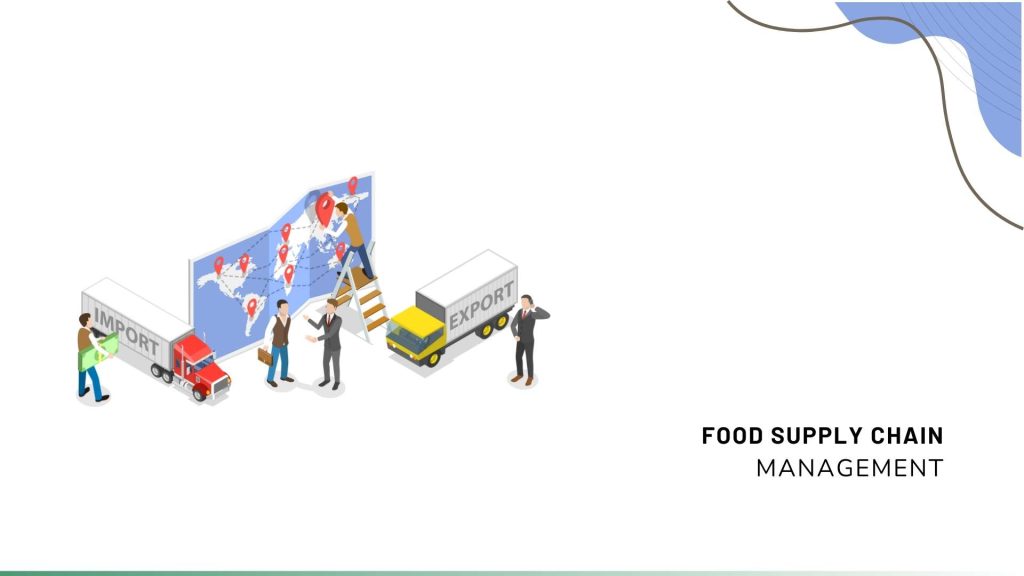The food supply chain has undergone significant transformations in recent years, influenced by technological advancements, consumer demands, sustainability concerns, and global events. This article delves into the latest trends, challenges, and strategies shaping the dynamic realm of food supply chain management.
Trends in Food Supply Chain Management
Technology Integration
- IoT and Blockchain: Implementing Internet of Things (IoT) devices and blockchain technology enhances traceability, transparency, and food safety throughout the supply chain.
- AI and Data Analytics: Leveraging artificial intelligence and advanced analytics optimizes forecasting, inventory management, and demand planning, enabling more efficient operations.
Sustainability and Environmental Responsibility
- Eco-Friendly Practices: There’s a growing emphasis on sustainable sourcing, reducing food waste, and implementing eco-friendly packaging to address environmental concerns.
- Local Sourcing: Consumers are increasingly drawn to locally sourced produce, encouraging supply chains to prioritize local partnerships and reduce carbon footprints.
Omnichannel Distribution
- E-commerce Expansion: With the rise of online grocery shopping, food suppliers are diversifying their distribution channels to include direct-to-consumer models, necessitating efficient last-mile delivery strategies.
- On-Demand Delivery Services: Quick and on-demand delivery options are gaining traction, pressuring supply chains to optimize delivery routes and fulfillment processes.
Resilience and Risk Management
- Supply Chain Resilience: Lessons from disruptions like the COVID-19 pandemic highlight the need for robust contingency plans, diversified sourcing, and adaptable logistics networks.
- Climate Change Adaptation: Climate-related challenges, such as extreme weather events, require proactive measures to mitigate risks and ensure continuity in the food supply.
Challenges in Food Supply Chain Management
Supply Chain Disruptions
- Global Crises: Pandemics, natural disasters, trade disputes, and geopolitical tensions disrupt supply chains, leading to shortages and logistical challenges.
- Transportation Bottlenecks: Issues like port congestion, trucking shortages, and container unavailability hinder the smooth flow of goods across the supply chain.
Demand Volatility and Consumer Preferences
- Shifting Consumer Behavior: Rapid changes in consumer preferences and buying behaviors necessitate agile supply chains capable of swift adaptation.
- Seasonality and Trends: Meeting seasonal demands and incorporating new food trends while maintaining efficiency poses a constant challenge.
Cost Management and Efficiency
- Rising Costs: Fluctuating fuel prices, inflation, and increased labor expenses impact operational costs, requiring efficient cost management strategies.
- Supply Chain Complexity: Managing complex networks involving multiple stakeholders, suppliers, and regulatory compliance adds layers of intricacy to cost management.
Strategies for Effective Food Supply Chain Management
Adopting Technology Solutions
- Digital Transformation: Embrace IoT, AI-powered analytics, and blockchain to enhance transparency, traceability, and operational efficiency.
- Supply Chain Digitization: Implement integrated software solutions for better inventory management, demand forecasting, and real-time tracking.
Embracing Sustainability
- Sustainable Sourcing: Partner with eco-conscious suppliers and invest in sustainable practices to reduce waste and environmental impact.
- Circular Economy Approach: Design supply chains prioritizing recycling, reuse, and waste reduction to create a circular economy model.
Flexibility and Collaboration
- Agile Supply Chains: Foster agility by establishing flexible production and distribution networks capable of adapting to changing market dynamics.
- Collaborative Partnerships: Cultivate strong relationships with suppliers, distributors, and stakeholders for seamless collaboration and risk-sharing.
Resilience and Risk Mitigation
- Diversification: Expand supplier networks and logistics options to mitigate risks associated with disruptions.
- Scenario Planning: Develop robust contingency plans and conduct scenario-based risk assessments to prepare for unforeseen events.
How Acumatica can enhance the food supply chain business
Acumatica, with its robust suite of cloud-based ERP solutions, stands as a catalyst for revolutionizing food supply chain businesses. Its adaptable modules cater specifically to the intricacies of this industry, offering seamless integration, real-time visibility, and advanced analytics. By leveraging Acumatica, food supply chain businesses can optimize inventory management, streamline operations, enhance traceability, and effectively respond to dynamic market demands.
The platform’s flexibility, scalability, and emphasis on data-driven decision-making empower organizations to navigate challenges, capitalize on emerging trends, and ultimately foster a resilient, efficient, and customer-centric supply chain ecosystem.

Vijay comes with a vast experience in ERP and enterprise solutions space with about 20 years of experience in various packaged application like Acumatica, SAP, Orion, Salesforce.com, SugarCRM and, SalesLogix.

